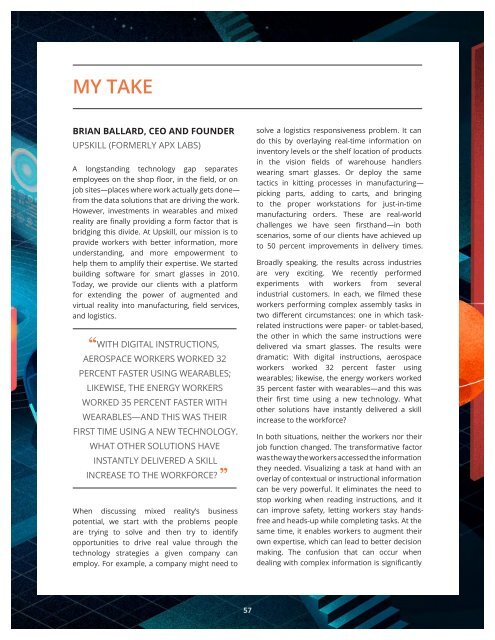Trending the trends Eight years of research
2kcf8xh
2kcf8xh
You also want an ePaper? Increase the reach of your titles
YUMPU automatically turns print PDFs into web optimized ePapers that Google loves.
Tech Trends 2017 The kinetic enterprise<br />
Series title / Magazine title / Document Subtitle - style “header-subtitle”<br />
MY TAKE<br />
BRIAN BALLARD, CEO AND FOUNDER<br />
UPSKILL (FORMERLY APX LABS)<br />
A longstanding technology gap separates<br />
employees on <strong>the</strong> shop floor, in <strong>the</strong> field, or on<br />
job sites—places where work actually gets done—<br />
from <strong>the</strong> data solutions that are driving <strong>the</strong> work.<br />
However, investments in wearables and mixed<br />
reality are finally providing a form factor that is<br />
bridging this divide. At Upskill, our mission is to<br />
provide workers with better information, more<br />
understanding, and more empowerment to<br />
help <strong>the</strong>m to amplify <strong>the</strong>ir expertise. We started<br />
building s<strong>of</strong>tware for smart glasses in 2010.<br />
Today, we provide our clients with a platform<br />
for extending <strong>the</strong> power <strong>of</strong> augmented and<br />
virtual reality into manufacturing, field services,<br />
and logistics.<br />
“WITH DIGITAL INSTRUCTIONS,<br />
AEROSPACE WORKERS WORKED 32<br />
PERCENT FASTER USING WEARABLES;<br />
LIKEWISE, THE ENERGY WORKERS<br />
WORKED 35 PERCENT FASTER WITH<br />
WEARABLES—AND THIS WAS THEIR<br />
FIRST TIME USING A NEW TECHNOLOGY.<br />
WHAT OTHER SOLUTIONS HAVE<br />
INSTANTLY DELIVERED A SKILL<br />
INCREASE TO THE WORKFORCE? ”<br />
When discussing mixed reality’s business<br />
potential, we start with <strong>the</strong> problems people<br />
are trying to solve and <strong>the</strong>n try to identify<br />
opportunities to drive real value through <strong>the</strong><br />
technology strategies a given company can<br />
employ. For example, a company might need to<br />
solve a logistics responsiveness problem. It can<br />
do this by overlaying real-time information on<br />
inventory levels or <strong>the</strong> shelf location <strong>of</strong> products<br />
in <strong>the</strong> vision fields <strong>of</strong> warehouse handlers<br />
wearing smart glasses. Or deploy <strong>the</strong> same<br />
tactics in kitting processes in manufacturing—<br />
picking parts, adding to carts, and bringing<br />
to <strong>the</strong> proper workstations for just-in-time<br />
manufacturing orders. These are real-world<br />
challenges we have seen firsthand—in both<br />
scenarios, some <strong>of</strong> our clients have achieved up<br />
to 50 percent improvements in delivery times.<br />
Broadly speaking, <strong>the</strong> results across industries<br />
are very exciting. We recently performed<br />
experiments with workers from several<br />
industrial customers. In each, we filmed <strong>the</strong>se<br />
workers performing complex assembly tasks in<br />
two different circumstances: one in which taskrelated<br />
instructions were paper- or tablet-based,<br />
<strong>the</strong> o<strong>the</strong>r in which <strong>the</strong> same instructions were<br />
delivered via smart glasses. The results were<br />
dramatic: With digital instructions, aerospace<br />
workers worked 32 percent faster using<br />
wearables; likewise, <strong>the</strong> energy workers worked<br />
35 percent faster with wearables—and this was<br />
<strong>the</strong>ir first time using a new technology. What<br />
o<strong>the</strong>r solutions have instantly delivered a skill<br />
increase to <strong>the</strong> workforce?<br />
In both situations, nei<strong>the</strong>r <strong>the</strong> workers nor <strong>the</strong>ir<br />
job function changed. The transformative factor<br />
was <strong>the</strong> way <strong>the</strong> workers accessed <strong>the</strong> information<br />
<strong>the</strong>y needed. Visualizing a task at hand with an<br />
overlay <strong>of</strong> contextual or instructional information<br />
can be very powerful. It eliminates <strong>the</strong> need to<br />
stop working when reading instructions, and it<br />
can improve safety, letting workers stay handsfree<br />
and heads-up while completing tasks. At <strong>the</strong><br />
same time, it enables workers to augment <strong>the</strong>ir<br />
own expertise, which can lead to better decision<br />
making. The confusion that can occur when<br />
dealing with complex information is significantly<br />
57


